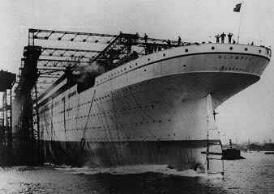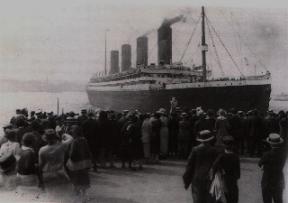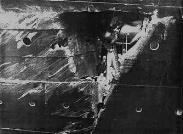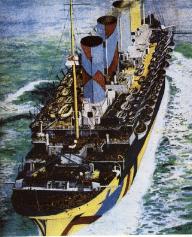
|
|
By October 1910 the Olympic's hull was complete and on Thursday 20th October the White hull was launched at Belfast. Officials stared in amazement as she slid into the water. Special guests included the Lord Lieutenant of Ireland and the Lord Mayor of Belfast. She took only 62 seconds to launch the huge 20,600 ton hull. As she slipped away, the giant hull of the RMS Titanic was slowly revealed to the guests. Olympic began her fitting. The £30,000 crane from Germany was used to place the funnels amongst other things. After fitting, she was dry docked in the newly completed Thompson graving dock (designed specially for the new generation of giants).
On the 31st May 1911 the Olympic was ready for duty. Coincidentally, on the very same day, the Titanic was launched. Titanic had already attracted over 100,000 witnessing her launch from slip way number three. After Titanic's launch the VIP guests were taken on board the Olympic. It would have been a glorious day for White Star Line. Not only could the guests witness the launch of the biggest ship in the world but they could also see a completed version waiting fully fitted for duty. INSIDE OLYMPIC The Olympic was the first of three sisters and was originally fitted with the various styles and graces found on the Titanic except for the Promenade decks which only ran half length. On her maiden voyage, Bruce Ismay had noticed that the open deck space on B deck was too large and not many passengers were using it. He soon rectified the position by ordering the RMS Titanic's plans to be changed to add more cabins to the promenade deck to create extra passenger space. Most of the Olympics interiors have been well photographed and in fact most books on the subject contain pictures from the Olympic not the Titanic because the Titanic was not in service long enough for the paparazzi to thrive in stories and pictures. [see inside the Titanic]
RMS OLYMPIC MAIDEN VOYAGE
At 4.30 p.m.Captain Edward J. Smith took the helm and steered the Olympic through Belfast Lough (accompanied by the Normadic and the Traffic, two passenger tenders constructed to aid the new liners) on to Liverpool. Olympic only stayed in Liverpool for a day before heading to Southampton. She arrived on June 3rd and immediately work began to prepare her for her maiden voyage. Vast quantities of food, linen, coal and china etc were carefully loaded aboard. Reporters gather around the ship taking photos for the world to see. A full time reporter form the Times accompanied the crew of the Olympic on her maiden voyage to record the occasion. Olympic handled like clockwork. Ismay was onboard to make his recommendations for change if any. Olympic travelled in style to New York. It took her 5 days 16 hours and 42 minutes. On some days, she would travel over 540 miles whist on others she would cover only 430. Her average speed was 21.7 knots. Bruce Ismay was pleased. He could not wait to inform his associate, Lord Pirrie that the RMS Olympic was "a marvel".
When they arrived in New York the on looking crowd must have been amazed. They would never had seen a ship of that size. Unfortunately, neither had the other ships in New York harbour who found out difficult to keep control in their berths as the Olympic passed. The O.L. Hallenbach suffered serious damage to her rudder and stern frame when the Olympic's propeller pulled her in. The Olympic was not damaged (except for a few marking to her paintwork). The Olympic finally docked at pier 59. She left America at 12 p.m. on 28th June 1911 and returned to Southampton on the 5th July. She had completed her journey in a quicker time averaging 22.5 knots. By mid September, Olympic had completed four return visits to New York.
THE HMS HAWKE INCIDENT
The fifth journey across the Atlantic was not successful at all. On the 20th September 1911 the Olympic collided with the HMS Hawke causing considerable damage to both ships. Order of Events:
The Hawke managed to stay upright but was very close to overturning. Both Captains ordered the watertight doors to be closed. Both ships were stopped so that damage could be assessed.
The fifth voyage of the Olympic was over. Passengers had to disembark at Osborne Bay to find alternative transport (like the Adriatic). The Hawke returned to Southampton for repairs. It took two weeks to repair the Olympics damage. The White Star Line wanted her to be back in service as soon as possible because she was the pride of the company. They would even delay the Titanic's maiden voyage if they had to. Which, considering what happened to the Titanic, may not have been such a bad idea. The Titanic sailed on time and hit the iceberg on 15th April 1912. If she did not sailed on time, the disaster may not have happened if the iceberg was not directly in Titanic's course. A Different situation altogether. As a matter of interest, the Titanic's propeller shaft was used to repair parts of the Olympic. Olympic returned to service on the 20th November 1911. She began her fifth voyage (technically her sixth). For the next few months it was plain sailing. Several more trips were made successfully. However, on the 24th February 1912 at 4:26 p.m. the Olympic shuddered and lost a propeller. It meant that she had to return to Belfast for yet more repairs. The track record of the ship was not going too well. Captain Smith made in all nine trips to New York. He was ordered to give up his position to Captain Herbert James Haddock to be the new Captain of the Titanic. He was one trip off retirement. He was at this point at the pinnacle oh his career.
OLYMPIC'S INVOLVEMENT WITH THE TITANIC DISASTER
Titanic left Southampton on April 10th 1912 to make her maiden voyage. Olympic left New York at 3 p.m. on 13th April. There was talk on the two ships that they would pass each other sometime on the way. On the 14th April 1912, the Titanic struck the iceberg and began to sink. Forty minutes after the collision, Captain Smith ordered the distress signal to be sent to other ships in the area. Haddock heard all the distress calls but did not realise the extent of the problem until about 1 a.m. on the 15th April. He knew he was over 500 miles away from the Titanic - over a days sailing away. Haddock replied to the Titanic that he was "lighting up all possible boilers." However, most ships the Titanic signalled were too far away. The Titanic sank with only one ship close enough to help but it was too late. Olympic had no choice but to return to Southampton on the Sunday 21st April. Her passengers were in a melancholic mood since they had heard the news of the Titanic. Some passengers would have had friends or relatives onboard the Titanic. They would have been eager to return home to look and the passenger lists posted by the White Star Line. Within a few days of return to Southampton, the Olympic had to undergo serious changes. The lifeboat capacity was examined with scrutiny. She was fitted with an extra 24 boats and more crew to man the boats. Many of the boats on the Titanic left without being full or properly manned by an able seaman. As with the Titanic, the Board of Trade wanted to inspect the changes prior to another voyage. Captain Maurice Clarke was in charge. He gave the ship a vigorous inspection. He ran mock lifeboat drills to try out the new davits. He was impressed with the improvement. It took and average of 12.5 minutes to lower each boat. The Olympic should have sailed on the 24th April 1912 but the trip was postponed, not because of a direct result of the Titanic disaster or the lifeboats, but because the crew refused to sail on a ship with collapsible lifeboats. They insisted on conventional open type wooden boats. They did not care that Captain Clarke was satisfied that the Olympic was safe. However, the White Star Line did not want listen to the crew. They would rather find another crew. The Olympic was taken to a secure dock off Spithead to find another crew. It was a demanding task (probably because crew hands had heard speculations about the conditions surrounding the sinking of the Titanic). Instead a trade union delegation offered a compromise. It appeared that the whole debate was how safe were the collapsible boats when floating in water for some considerable time. Most collapsible boats on the Titanic drifted off when the ship slowly sank. Would this happen again. Six collapsible boats were lowered and left in the water for two hours and then examined to see how much water they contained. Five out of the six were snuff dry but the sixth had a small leak but it took two hours for the water to appear. It could easily have been bailed out during use. It was agreed that the boats were indeed safe. The sixth boat was duly replaced and 168 new crew members joined the ship. Unfortunately, the original crew were not only dissatisfied with the lifeboats but with the new crew. They saw them as inexperienced and undesirable to have around. The felt so strongly about their position that some (over 60) deserted their posts. The Olympic was now two days behind schedule. So on the 26th April at 3 p.m. the White Star Line formally cancelled the voyage. The Olympic returned to Southampton so that the passengers could get off. The next scheduled trip was set for the 15th May. It gave the White Star Line enough time to find union approved crew and boats. On 22nd May 1912, the RMS Olympic arrived in New York once again (for the first time since the sinking of the Titanic). As soon as she docked Senator William Alden Smith , Chairman of the American Congressional Committee, was in charge of the American Enquiry in to the loss of the Titanic. Obviously he was checking the capacity of the ship and her safety features. He was shown how the lifeboats worked. The watertight doors were also inspected. Smith seemed satisfied. It must have been strange for Captain Haddock to have to face. His ship was under scrutiny form his own crew and from the American authorities. The whole world must have been watching him. The Olympic went on to make several more trips before she was recalled for more modifications. Every suggestion, comment and ruling following the Titanic Enquiry was heeded. The hull was gutted to install extra bulkheads and the transverse bulkheads were raised to make the ship float longer in an emergency. By the 22nd March 1913 the completely refitted Olympic departed from Belfast and returned to Southampton. She made her first crossing on the 2nd April. She was just over one year old. The year was a good one for the White Star Line. Twelve months had passed since the tragedy of the Titanic. Olympic would not suffer from the same mistakes as those of the Titanic. She was fitted with more appropriate safety measures and was gaining more and more popularity.
THE WAR YEARS
Britain and France declared war on Germany on the 4th August 1914. The war would last for four years and would have a dramatic effect on the whole world. As can be appreciated there would be many Americans and Canadians and other nationalities that did not want to be in a country during war times. Passages were being filled quickly but there were only so many trips that could be done. Olympics first real hand in war times came on October 27 1914 when she was ordered by the HMS Liverpool to evacuate the crew of the British Battleship Audacious who had struck a mine off Toy Island. For gratitude for the rescue, Captain Haddock was made a commander of merchant ships based in Belfast fitted to look like battleships to confuse the enemy. However, the episode of the HMS Audacious was very tame compared to what was about to happen. On 1st September 1915 the SS Olympic received a telegram requiring her for urgent Government service. It was time to prepare her for war. She had return to Harland & Wolff to complete this. To have to fit a ship out for war is the biggest nightmare for a shipping company. Firstly, governments only pay flat rates for the loan of vessels like the Olympic (£23,000 per month) and from this rate the shipping company would have to pay their staff and crew etc and often ran at a loss as the White Star Line would find out. Secondly, market values of ships were never agreed to between the companies and the Admiralty. Questions about who would pay for the ship if it was sank. Didi they need their own insurance? The White Star Line decided to insure the excess amount themselves at their own expense. Olympic was ready for service on the 24th September 1915. She was given the transport name T2810 . Her job was to transport troops to different countries. Her first call was Mudros to drop off 6,000 troops. They arrived after a few adventures on the way. They picked up marooned French sailors from the French Steamer Provincia and dropped them with the SS Aragon . Their second call was to Spezia and then back home for the 21st December for a well deserved break. The next trip would not take place until 4th January. The only other point of interest during her war years occurred on the 24th April 1918. The Olympic was sailing the English Channel where after careful planning by Captain Hayes (who replaced Haddock), the German U boat U103 was struck full on by the Olympic and sank. Hayes was awarded the DSC. In November 1918 the German government surrendered. Peacetime was once more. The war may have been over but British troops were still posted all over the world. Olympic continued to make the round trips but only to bring troops home.
POST WAR
By August 1919 the Olympic was ready to be refitted as a transatlantic liner. Work was carried out throughout 1919 and on to 1920. On 17th June Olympic was finally ready. A celebration party was held on board on to celebrate the return of the "Old Reliable". She was on her way to New York on 26th June 1920. Olympic proved to be more popular than ever. Reports were given on how much passengers used the swimming baths and Turkish baths. Charlie Chaplin sailed on her enjoying the card games in the smoking room. Captain Hayes enjoyed his last voyage ob 21st December 1921. He was given the command of the Adriatic. He was at his pinnacle of is career, just like Captain Smith before the loss of the Titanic. Hayes would be replaced by Captain Alec Hambleton from the Adriatic. In 1930 it was clear that the old ship was ageing. Already in 1927 work had been carried out to the bridge. This time repairs were estimated at £100,000. The White Star Line did not want to spend that much so extensive welding repairs were settled for. By 1931 other stress cracks had appeared near the funnels. The Board of trade would only certify the ship as safe for a period of six months (presumably to review the situation six months later). However, in March 1933, the Board of Trade did give the all clear. In the Autumn of 1931 the White Star line and the Cunard Line merged. The White Star Line's contribution to the merger were the giving of 10 ships, one of which was the Olympic. It was suspected though that the Olympic would not last much longer. Disaster struck for the Olympic on the 15th May 1933. Under the command of Captain John Binks , the Olympic smashed into the Nantucket Lightship totally destroying it. The sheer height of the Olympic and her speed made it impossible for her not to cause damage to smaller ships. The feeling of the Titanic were stirred up once more. Captain Smith is said to have ploughed through the ice too fast and ultimately when he hit the iceberg it was too late. Following the lightship incident the usual law suits flew up to a staggering $500,000. In January 1935, it was announced that Olympic must resign from service and be withdrawn. She stood abandoned for a little over six months. In September that year she was sold for £100,000 to Sir John Jarvis who then sold her to the Jarrow ship breakers of Thomas Ward & Sons . Olympic had been in service for 24 years. Her interiors were stripped and sold off London Auctioneers of Knight, Frank & Rutley . There were 4,456 lots. The general public could not view the items but only see descriptions in a catalogue which cost two shillings and six pence. The Order of sale lasted nine days.
The Old Reliable is stripped and Auctioned
First Day - Tuesday November 5th 1935 Sun Deck - Chart rooms, Wheelhouse, Officers Quarters LOTS 1-216 Promenade Deck - State Cabins 1-46, bath rooms etc. First Class lounge, Drawing and smoking rooms, Verandas, Cafes and services, First class staircase gallery, etc&ldots; LOTS 217-497 Second Day - Wednesday November 6th 1935 "A" Deck - Cabins 1-71. First Class kitchens, Reception restaurant and smoke rooms and Parisien Café. LOTS 498-84 "E" Deck - Starboard cabins 15-37 LOTS 850-928 Third Day - Thursday November 7th 1935 "B" Deck - Purser's Office, starboard cabins 1-125. Port cabins 2-60, bath rooms etc LOTS 929-1338 Fourth Day - Friday November 8th 1935 "B" Deck - Port Cabins 62-148, bath rooms, tourist smoking room, library and lounge and hospital LOTS 1339-1545 "C" Deck - Fore, Surgery, Third class lounge and smoking room and tourist cabins 1-46 LOTS 1546-1767 Fifth Day - Monday November 11th 1935 "C" Deck - First class reception, dining room, vietualling department, kitchens and services. Tourist dining rooms and lounges. LOTS 1768-2026 Tourist cabins 51-89 and 181-196 LOTS 2027-2186 Sixth Day - Tuesday November 12th 1935 "D" Deck - No.1 and No. 2 Sections, Fore. Cabins 27-54. Tourist cabins 5-111, bathrooms LOTS 2187-2620 Seventh Day - Wednesday November 13th 1935 "D" Deck - Crews Quarters and mess room LOTS 2621-2728 Tourist cabins (aft) 112-227 LOTS 2729-2785 "E" Deck - Crews Quarters (Fore and "J" section LOTS2786-2907 Third Class dining rooms and services, tourist cabins (aft) 15-35 LOTS 2908-3053 Eighth Day - Thursday November 14th 1935 "E" Deck - tourist cabins (aft) starboard side 39-69 and port side 16-64. "R" section (aft) cabins 224-244. Swimming and elections baths. Linen and drying rooms. Engineers' and electricians' cabins. LOTS 3054-3464 Ninth Day - Friday November 15th 1935 Panelling, flooring, staircases, mantel pieces and passenger lifts LOTS 3465-3969 Tenth Day - Monday November 18th 1935 "F" Deck, Fore - Crews Quarters LOTS 3970-4066 Ships instruments, machinery, lifeboats, davits, winches, fans etc LOTS 4067-4456
|




